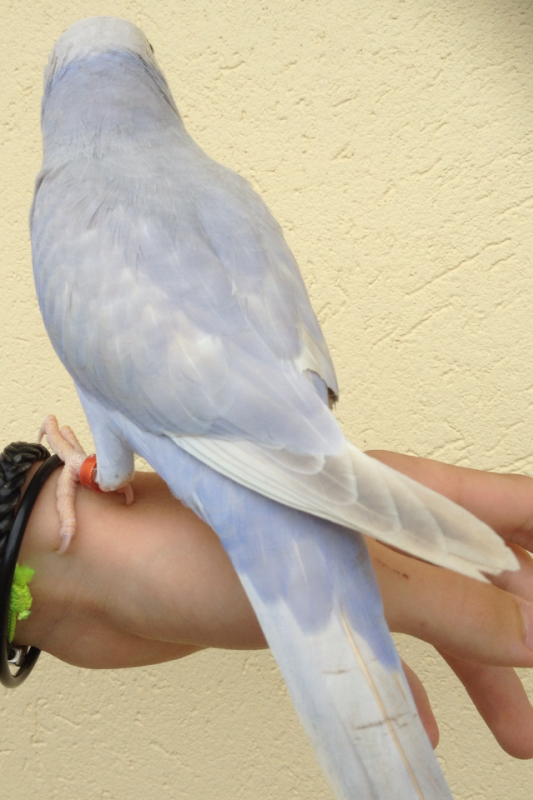Tail colouration question for Pallids
Moderator: Mods
Tail colouration question for Pallids
At the moment my 7 month old Pallid hen has a 'clear' tail- can anyone tell me when I could expect it to get some colouration?
Re: Tail colouration question for Pallids
surely someone must have bred some Pallids and kept them until maturity?
Re: Tail colouration question for Pallids
Sheyd, I have bred many. You have not said if it is Green or Blue series. In my experience Blue Pallids will never have much colour in the tail, never getting better than 'dirty' white. Green series birds will have plenty of colour in the tail.
Re: Tail colouration question for Pallids
Hi Shey,
My Deep blue Pallid has full colored tail but the indigo pallids have clear tails, all 2012 birds.

My Deep blue Pallid has full colored tail but the indigo pallids have clear tails, all 2012 birds.

Re: Tail colouration question for Pallids
Ben, nice bird, I had not noticed the Deeps and Darks etc colouring the tail in Blue Pallid birds. That bird I sold you looks like a Deep Violet Pallid which was also possible.
Re: Tail colouration question for Pallids
Willy,
The deep blue pallid in the pic is from you. he looks great and it developed into a nice big bird.
i did not keep the deep?violet pallids , no room to keep for 2 years young pallid cocks (deep blue pallid is an exception)
The deep blue pallid in the pic is from you. he looks great and it developed into a nice big bird.
i did not keep the deep?violet pallids , no room to keep for 2 years young pallid cocks (deep blue pallid is an exception)
Re: Tail colouration question for Pallids
Hi Ben,was asking for either series. Thanks for the pic-
I have noticed with Ron's http://www.fabulousparrots.com.au/photos birds, that they are nicer (as one would expect) with Deep being involved- their tails are not the 'dirty' colour, Pallid's without deep usually get.
Since all of his have coloured tails and all the mature one's I've actually seen- I was wondering when they 'colour up' my Violet Blue (possibly also Dark) Pallid's tail is stark white- with a violet tinge down some of the outter tail feathers.
I am waiting with anticipation for her next moult.

I have noticed with Ron's http://www.fabulousparrots.com.au/photos birds, that they are nicer (as one would expect) with Deep being involved- their tails are not the 'dirty' colour, Pallid's without deep usually get.
Since all of his have coloured tails and all the mature one's I've actually seen- I was wondering when they 'colour up' my Violet Blue (possibly also Dark) Pallid's tail is stark white- with a violet tinge down some of the outter tail feathers.
I am waiting with anticipation for her next moult.
Re: Tail colouration question for Pallids
Deon also mentions that there are a number of pallid strains/phenotypes. If I recall, he mentioned 4. And of course, as Madas has mentioned, the phenotype of pallids can vary depending on whether they are used in a pallid only breeding line, or whether SL ino is brought into the mix which can dilute the colour even further. The situation is similar here in SA with wide variety. I visited a breeder a couple of months ago and he showed me what I thought was a pallidino. Yet, it was a female, so it must have been a pallid hen.
Re: Tail colouration question for Pallids
yes, have often wondered if some of the paler Pallids had been purposely line bred- I was unaware that there are/could be 4 strain types- I'd be interested to find out more about those (and which one I may possibly have). Just looked back at the picture of the Pallid cock bird of my hen and he appears to have a white tail- time will tell what will happen with her I guess.
I have also seen a very pale Pallid hen- she was so pale that I too thought she was a Pallidino, but when I asked if it were a male they said that no it was definitely a hen (line bred maybe?)- so yes- I agree there is much variation.
I have also seen a very pale Pallid hen- she was so pale that I too thought she was a Pallidino, but when I asked if it were a male they said that no it was definitely a hen (line bred maybe?)- so yes- I agree there is much variation.
Re: Tail colouration question for Pallids
The light color of some pallids isn't mostly caused by linebreeding. As Johan said they were often mixed with SL inos and resulted in a lighter phenotype.sheyd wrote: (line bred maybe?)
Reversing this effect will taken years. So my advise if you like to start with the pallid series. Try to buy the "darkest" female regarding the pallid gen and
start your breeding program with her. Keep your pallids clean from ino. Means if buying new birds always buy females. Split birds and male should be breed
by your own.
madas
btw: Ron is (was) owning some very nice and dark pallids.
Re: Tail colouration question for Pallids
Furthermore line breeding is used to enhance some specific patterns and so it makes no sence to line breed pallids to get a lighter phenotype. ;)sheyd wrote: (line bred maybe?)
madas
Re: Tail colouration question for Pallids
Unless the specific pattern is too lighten the bird.madas wrote:Furthermore line breeding is used to enhance some specific patterns and so it makes no sence to line breed pallids to get a lighter phenotype. ;)
madas
Example: One of my goals have been to line breed the dark mutation in IRN to see at what point it becomes destructive like in the white eye ring group of lovebirds where a mauve x cobalt or mauve to mauve pairing is known to cause problems. This is me going in one direction. But, what IF (just speculating for the fun of it) the Oz deep turns out to be allelic to dark? And it turns out somebody else went the other direction and selected to breed with lighter birds. Most likely not to have happened in real life, but to me it makes a lot of sense to line breed to both sides of the pattern.
@Madas, I have a question for you: We currently know that variety exists for "bronze fallow" in the head colour ranging from completely melanin free to about 50% melanin evenly distributed over the head. Which do you think represent the true mutation? I.e. in our line breeding efforts, should we aim towards cleaning up the head completely, or to get it as dark as possible? Is there a right or wrong answer, or does it boil down to preference?
My personal preference is towards the darker head colour. My reason is that it distinguished the phenotype better from a pallid, CHF and even cleartail by retaining a darker head compared to those mutations.
Re: Tail colouration question for Pallids
Until now we don't know if we deal with one or two or three distinct mutations. So then it's proven that we deal with one and same mutation then we can discuss the head color question.Johan S wrote: @Madas, I have a question for you: We currently know that variety exists for "bronze fallow" in the head colour ranging from completely melanin free to about 50% melanin evenly distributed over the head. Which do you think represent the true mutation? I.e. in our line breeding efforts, should we aim towards cleaning up the head completely, or to get it as dark as possible? Is there a right or wrong answer, or does it boil down to preference?
But i understand what you wan't to say with your last answer. And i think you understood mine. ;)
madas
Re: Tail colouration question for Pallids
Yes I do, just reminding you of the other side of the coin. 
In terms of proving the fallows unique mutations, it will be tough. Tienie has bred two splits from the different lines together and produced a red eyed youngster that later died. Another breeder has shown me light and dark headed fallows from the same clutch. Currently, I'm at a bit of a loss. I suspect two alleles. But it could also be double splits in a gene pool completely contaminated due to excessive inbreeding.
In terms of proving the fallows unique mutations, it will be tough. Tienie has bred two splits from the different lines together and produced a red eyed youngster that later died. Another breeder has shown me light and dark headed fallows from the same clutch. Currently, I'm at a bit of a loss. I suspect two alleles. But it could also be double splits in a gene pool completely contaminated due to excessive inbreeding.
Re: Tail colouration question for Pallids
update:
The first major moult has just passed, and two things stand out to me- one of which I wasn't expecting- she's lighter now than what she was before (which isn't very exciting- and what I wasn't expecting ) and two, her tail has some colouration- but in the form of light self coloured bands (bit hard to see- click for a smaller view in pb).
I've since also found out that Dark is unlikely for this bird through the breeders results from this past season.


The first major moult has just passed, and two things stand out to me- one of which I wasn't expecting- she's lighter now than what she was before (which isn't very exciting- and what I wasn't expecting ) and two, her tail has some colouration- but in the form of light self coloured bands (bit hard to see- click for a smaller view in pb).
I've since also found out that Dark is unlikely for this bird through the breeders results from this past season.

